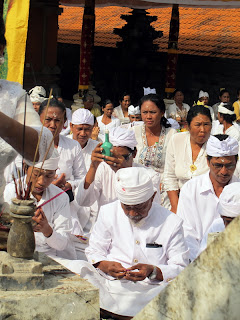Wednesday, 19 September 2012
Friday, 14 September 2012
TRAVEL DIARIES: Palu, Sulawesi
Palu, Sulawesi
The central province of Sulawesi is naturally splendid and culturally rich, and is now easily accessible from Makassar (Ujung Pandang). Palu, the arrival town, sits on Indonesia’s biggest harbor and is the gateway to the Tongean Islands and the megalith strewn villages of the Palu and Poso valleys. It is a great mix of ancient and modern in a diverse geographic setting. Long a mecca for bird-watchers and trekkers it is now attracting divers and archaeologists.
I did a Palu-lite two day side-trip on my way to Kuala Lumpur via Makassar (Air Asia now flies three times a week). I stayed at the delightful Swiss Bell-Inn on Palu Bay between Central Sulawesi’s best seafood restaurant, The Taman Ria, and Donggala, Kota Antik, the colonial-era port. Just beyond Donggala is Tanjung Karang beach which has a great dive hotel, the Prince John, and some great budget beachside accommodation too.
I spent my first day exploring the towns Lolo Dondo on the approach to Donggala, and the old port of Dongala itself, now a picturesque ruinscape of rusty WW II era hangars plus a dilapidated but still handsome harbor-master house.
I love the quasi-colonial and the quaintly-rustic so was in seventh heaven exploring the nooks and crannies of this once prosperous coastline (the main port has moved across the bay).
Inside a derelict harbor-side godown I found a warung with a five-star curry. Such discoveries are the mainstay of any tourism-lite adventure in Indonesia and many Palu Bay-side towns really deliver in the fish-curry department!
At the warung were a gang of old crones culled from Kota Antik Central Casting: A Bugis boatswain with buck teeth; s salubrious Muslim sirene with a face only a Brother could love, caked with whitening paste; a pair of thirty — something sumo wrestler mums going at each other’s head lice.
Around the bay at Tanjung Karang I found half of Palu’s available teenagers in baclavas and leather jackets, and other in appropriate beachwear, smoking out a line of sky blue beach huts. It was standing room only on the beach and in the smoking section: fully dressed domestic tourists frolicked in the shallows like sea otters at a life guard demonstration. Further down the beach at the rather solemn, all-white Prince John dive hotel a group of French Alsacians were savaging the bartender over an errant bill (I quickly dived back into the smoking section after an excellent mixed juice — the local produce is amazing as Palu Valley is one of the most fertile places on the planet).
• • •
In the hills behind my hotel in Tolare village I discovered an ancient tribe of Austronesian hunters and gatherers with an orientation centre run by a self-proclaimed Universal Wizard. For a small donation one got a warm stale coke, a fresh kretek cigarette and a lecture on the power of the betel nut palm. I was intrigued by this Proto-Malay community and decided to visit the museum to continue my research into the peopling of the Indonesian Islands from South Taiwan during pre-historic times.
15 September 2012: To the Central Sulawesi Museum to research early Austronesian links
The museum is Soviet Era set sprawling Sulawesi modern: Bulky pseudo-ethnic architecture within Toy Town gardens. Light bulbs are missing but the topiary is immaculate. Giant painted concrete mushrooms protect priceless 3000 year old menhir (stone totems) form the mid-day sun (inside the main hall the ethnographic collections — costumes, jewellery, tribal artifacts, ancient Implements — is most enlightening.
I discover a map of the ‘temple sites’ of the Palu valley done by Swedish anthropologist Walter Kaulden in 1926 and a painted tree bark vest identical to ones I have seen in the Shung Ye Museum of Formosa Aboriginals in Taipei. Japanese anthropologists are onto this link too I was told. Indeed the Palu Valley megaliths are very similar to those found in the ancient villages of South Taiwan (Formosa Island) and Northern Philippines and anthropologists agree that the Neolithic culture of the Formosan Aborigines and many tribes people spread into Indonesia from 40,000 B.C. onwards.
Palu Bay is certainly an obvious place for ancient manners to have come ashore and eventually head for the hills (away from marauding sea-gypsies).
Another section of the museum contains a collection of Central Sulawesi textiles including the exquisite ikat cloth of Donggola, much prized across the archipelago.
• • •
After the museum I visited the home of the former ‘raja’ of Palu — a Bugis stilt-house which was once on the bay’s edge (the bay edge has since shifted a few hundred metres). Photos of the former royal family show a distinct..
North coast Java influence in their choice of formal wear — the ladies in Lasem batiks and the men in Javanese noblemen’s black velvet and silver brocade jackets. The pride of the palace museum is a late 19th century Singer sewing machine once used by the royals.
• • •
After two days in Palu I was primed and ready for more adventure in Central Sulawesi, particularly in the islands of the coast, but that will have to wait.
Footnote:
My godson in Stockholm, Wayan Leksi, tracked down famed Swedish anthropologist Walter Kauldern’s 1920s book on his research in the Palu Valley and sent me some scans. The ancient ‘temples’ referred to on the settlement area map in the Palu museum were in fact handsome squat stilt houses, almost identical to models I have seen photographs of in the Northern Philippines and amongst those of the Pinyin tribes people in Southern Taiwan. This travel writer’s migration theory that puts Central Sulawesi as a major hub for early (2500 BC) Austronesian migration into the Indonesian archipelago is gaining credence. It’s always good to have a quest on the back burner. |
Subscribe to:
Comments (Atom)
























































 Palu Museum, Central Sulawesi
Palu Museum, Central Sulawesi




